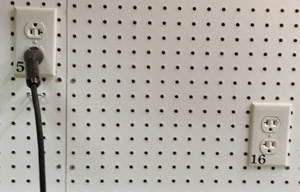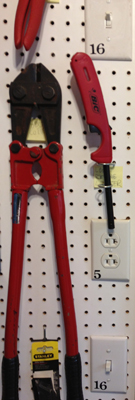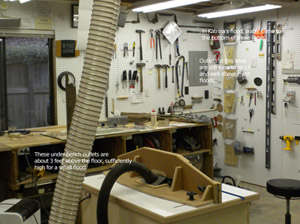Tips From Sticks-In-The-Mud Woodshop
by Jim Randolph
Long Beach, Mississippi
Click on any picture to see a larger version.
Welcome to "Tips From Sticks-In-The-Mud Woodshop." I am a hobbyist, not a professional, someone who loves woodworking, just like you do. I have found some better ways to accomplish tasks in the workshop and look forward to sharing those with you each month, as well as hearing your problem-solving ideas.
Tip #1
Some of my shop is wired with 10 gauge wire for tool outlets. Others are wired with 12 gauge wire for vacuums, supplemental lighting, etc.

|
|
The outlet on the left is in Circuit 5, which I happen to know is wired with 10-gauge wire and can handle heavy current loads. Shown is the plug for the Dewalt power miter saw. If something plugged into a "5" outlet doesn’t work, I instantly know which breaker to check.
|
Each outlet is boldly numbered (with neat, peel-and-stick plastic numbers) corresponding to the breaker number. Thus, I know that my "5" outlets are high-power ones and my "16" outlets are for low-current-draw tools or lights.

|
|
"16" is a circuit with lights and outlets for such low-draw items as my pencil sharpener.
|
And, if a tool stops working when plugged into a certain outlet, I automatically know which breaker to check. Some will say that 10-gauge wire is wasteful, but my response is: a) my nickname is Lt. Overkill and, b) heat kills. When your tool is getting maximum power delivered without current reduction caused by smaller wire, your tool is naturally going to last longer and deliver its full potential.
Tip #2
No Southern-fried Southern boy wants to be called a Yankee, but we share the characteristics of shrewdness and thrift. Thus, each month we include a money-saving tip. It's OK if you call me "cheap."
During Katrina my shop was flooded to within inches of the ceiling-mounted lights. Every inch of wire going to outlets and switches had to come out. If you are designing a new shop or remodeling an existing one, and you are subject to flooding, consider raising your outlets to 3 or 4 feet off the floor.

|
|
Because of our need to return to our veterinary practice quickly after hurricanes, we never evacuate. In Katrina, we watched the water march up higher and higher, almost reaching these fluorescent light fixtures. The lowest outlets in the shop are now three feet from the floor.
|
Not only will that save you from rewiring in a small flood, but your outlets will be up high, where your hands and your tools are.
Jim Randolph is a veterinarian in Long Beach, Mississippi. His earlier careers as lawn mower, dairy farmer, automobile mechanic, microwave communications electronics instructor and journeyman carpenter all influence his approach to woodworking. His favorite projects are furniture built for his wife, Brenda, and for their children and grandchildren. His and Brenda's home, nicknamed Sticks-In-The-Mud, is built on pilings (sticks) near the wetlands (mud) on a bayou off Jourdan River. His shop is in the lower level of their home. Questions and comments on woodworking may be sent to
DrRandolph@MyPetsDoctor.com
. Questions about pet care should be directed to his blog on pet care,
www.MyPetsDoctor.com
. We regret that, because of high volume, not all inquiries can be answered personally.
Return to
Wood News
front page


